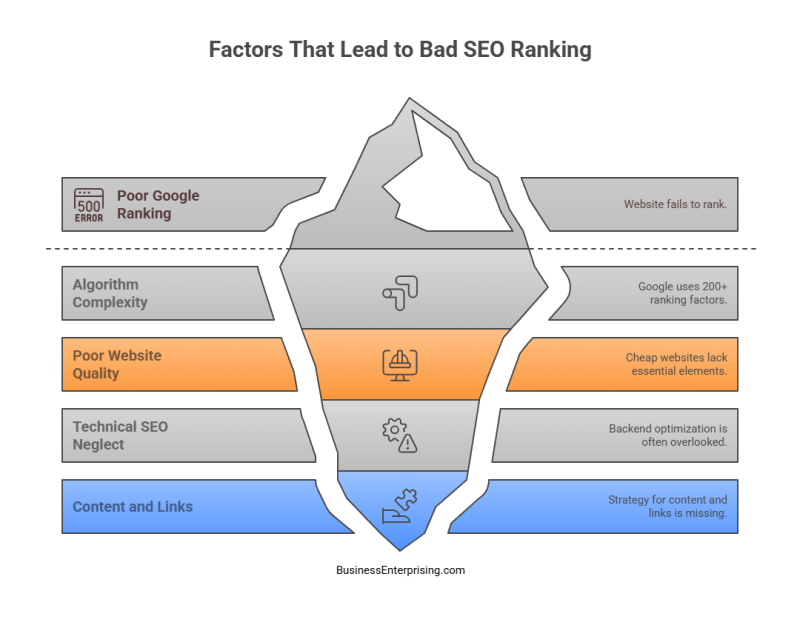
The Complexity of Google’s Ranking Algorithm
Getting your website to rank on Google takes more than just building pages and adding keywords. Google’s algorithm is complex. It weighs over 200 factors to decide where your site should appear. Therefore, understanding those factors helps you compete for better visibility.
Additionally, Google uses both on-page and off-page signals. That means your content, structure, backlinks, and speed all matter. The more relevant and high-quality your site appears, the more favorably Google treats it. As a result, stronger websites rise higher in search results.
Google also updates its algorithm frequently. These changes often reflect shifts in user behavior and technology. Therefore, what worked a year ago may not work now. You must adapt and improve to keep up. This includes reviewing content, adjusting keywords, and checking performance regularly.
Moreover, machine learning now plays a larger role. Google looks for patterns and behaviors to better match results with intent. It tracks how users interact with your pages. If people bounce quickly, that sends a negative signal. If they stay and click, that builds trust.
For e-commerce websites, this complexity adds pressure. You need to manage SEO while also selling products. Every product page, image, and headline affects your ranking. Therefore, you must treat SEO as part of your overall business strategy.
Even small improvements can shift your position in search results. Focus on clarity, structure, and relevance. Build authority over time. Additionally, monitor how your site performs and make changes based on the data. A smarter, more consistent approach will help you compete effectively.
The Pitfalls of Cheaply Made e-Commerce Websites
Cheaply made websites often look fine on the surface but lack the structure needed to compete online. You might save money upfront. However, those savings can cost you long-term visibility and growth. Design shortcuts create deeper issues behind the scenes.
Additionally, poorly built e-commerce websites often skip essential features. They may lack clean code, mobile optimization, or proper content. Without these elements, Google struggles to understand your site. As a result, you fall behind competitors who invested more in development.
Moreover, thin content is common with lower-cost builds. Many pages lack product descriptions, metadata, or internal links. Therefore, search engines see less relevance and authority. You miss ranking opportunities and limit your reach. A small investment in content often pays off with more traffic.
Visual quality also suffers when budgets are tight. You may end up with stock photos, outdated layouts, or inconsistent branding. These details hurt trust. Additionally, users are less likely to stay on a site that looks unprofessional. Bounce rates increase, and conversions drop.
Functionality issues are just as damaging. Poor navigation, broken buttons, or slow load times frustrate users. Therefore, they abandon your site before completing a purchase. That behavior signals to Google that your site lacks value.
Even if you offer great products, a weak site can hide your potential. E-commerce websites must look good, work smoothly, and meet technical standards. You can’t afford to cut corners. Build a solid foundation now, and your site will serve your business better for years.
Proper Coding
Proper coding is fundamental to a website’s performance and search engine visibility. Poorly coded websites can suffer from slow loading times, broken links, and security vulnerabilities, all of which negatively impact user experience and search rankings. For instance, a website with excessive JavaScript, large images, or unoptimized code will load slowly, causing users to abandon the site and signaling to Google that the site offers a poor user experience.
Moreover, proper coding ensures that a website is mobile-friendly. With the increasing use of mobile devices for browsing, Google prioritizes mobile-friendly websites in its rankings. Responsive design, which adapts a website’s layout to different screen sizes, is a critical aspect of mobile-friendliness. Websites that fail to implement responsive design risk being penalized by Google and losing valuable traffic.
Adequate Content
Content is king in the world of SEO. High-quality, relevant content not only attracts and engages users but also signals to Google that a website is authoritative and valuable. However, many cheaply made websites skimp on content, offering only minimal information about their products or services. This lack of content limits their ability to rank for relevant keywords and topics, reducing their visibility in search results.
Furthermore, content must be regularly updated to remain relevant and effective. Google favors websites that provide fresh, up-to-date content, as it indicates that the site is active and maintained. Blog posts, articles, and other forms of content marketing are effective ways to keep a website updated and attract organic traffic. By investing in high-quality content creation, businesses can improve their search rankings and build a loyal audience.
Visual Aesthetics
Visual aesthetics play a significant role in user experience and engagement. A visually appealing website can capture users’ attention and encourage them to explore further, while a poorly designed site can drive them away. Cheaply made websites often lack professional design elements, resulting in a cluttered, unattractive appearance that deters visitors.
Additionally, visual aesthetics influence the perceived credibility and trustworthiness of a website. Users are more likely to trust and engage with a site that looks professional and well-designed. High-quality images, clean layouts, and consistent branding are essential elements of good web design that can enhance user experience and improve search rankings.
Conversion Rate Optimization
Finally, the ability to convert visitors into customers is a critical factor for e-commerce websites. Conversion rate optimization (CRO) involves designing a website in a way that encourages users to take desired actions, such as making a purchase, signing up for a newsletter, or filling out a contact form. Cheaply made websites often overlook CRO, resulting in low conversion rates and missed opportunities for business growth.
Effective CRO strategies include clear calls-to-action (CTAs), user-friendly navigation, and streamlined checkout processes. By optimizing these elements, businesses can increase their conversion rates and improve their overall return on investment (ROI). Moreover, a high conversion rate signals to Google that a website is valuable and relevant, positively impacting its search rankings.
The Importance of Technical SEO
Technical SEO is the foundation that supports your visibility in search engines. Without it, your content may never get found. Google needs to crawl and index your site efficiently. Therefore, your site structure, code, and settings must work together.
Additionally, site speed plays a major role in performance. A slow-loading page can drive visitors away quickly. That behavior signals to Google that your site lacks value. As a result, your rankings drop, and traffic suffers. Simple fixes can make a big difference.
Moreover, mobile optimization affects both user experience and rankings. Google favors mobile-friendly websites in search results. If your layout breaks on small screens, users leave. Therefore, you must test your site across different devices and fix what doesn’t work.
Crawlability is another key factor. Search engines need clear paths to follow. A solid site map and internal linking help guide crawlers through your content. Additionally, your robots.txt file must be correctly configured. One bad setting can block important pages from being indexed.
Security also matters to search engines. Sites with SSL certificates gain a ranking advantage. Therefore, you should use HTTPS across your entire website. It builds trust with users and adds technical credibility.
For e-commerce websites, technical SEO is not optional. Every product page, filter, and category needs to be optimized. Otherwise, your pages may never appear in search results. By focusing on the backend, you improve the front-end results. A strong technical setup supports better visibility, traffic, and long-term growth.
In addition to the elements mentioned above, technical SEO is another critical aspect of achieving good organic search engine placement. Technical SEO involves optimizing the backend of a website to improve its performance, crawlability, and indexability by search engines. Key technical SEO elements include:
Site Architecture
A well-structured site architecture makes it easier for search engines to crawl and index a website’s pages. This involves organizing content into logical categories, using descriptive URLs, and implementing internal linking strategies. A clear site structure enhances user experience and helps search engines understand the relationship between different pages.
XML Sitemaps
XML sitemaps provide search engines with a roadmap of a website’s pages, making it easier for them to discover and index new content. Regularly updating XML sitemaps ensures that all pages are included and accurately reflected in search engine indexes.
Robots.txt
The robots.txt file instructs search engine crawlers on which pages to crawl and index. Properly configuring the robots.txt file prevents search engines from wasting resources on irrelevant or duplicate pages, improving the overall efficiency of the crawling process.
SSL Certificates
Security is a top priority for Google, and websites with SSL certificates (HTTPS) are favored in search rankings. SSL certificates encrypt data transmitted between a website and its users, ensuring a secure browsing experience. Implementing SSL certificates not only improves security but also boosts search rankings and user trust.
Content Strategy and Link Building
Content strategy and link building are two of the most effective ways to increase your site’s visibility in search engines. Without them, it’s hard to gain organic traffic. Good content attracts readers, and links show search engines that your site has authority.
Additionally, content should address your audience’s needs. Focus on helpful topics that match what people search for. Blog posts, guides, and product descriptions all play a part. Therefore, your writing should be clear, relevant, and easy to update as your business grows.
Moreover, consistency helps build trust. Regular publishing shows that your site is active and reliable. Search engines notice when fresh content appears. As a result, your pages may rank higher and reach more users. You don’t need to post daily, but you do need a plan.
Link building supports your content by improving its credibility. High-quality backlinks from trusted websites carry weight. These links act as recommendations. Therefore, they signal to Google that your content is worth showing in search results.
Outreach plays a big role in building links. Additionally, shareable content increases the chance that others will link to your site naturally. Focus on value first. Then make it easy for others to reference your work.
For e-commerce websites, both strategies matter. Product pages alone won’t drive long-term traffic. You need content that informs and links that validate. By combining these efforts, you strengthen your brand and boost your rankings.
Conclusion
In conclusion, while having a business website is essential, ensuring that it ranks well on Google requires a comprehensive approach to SEO. Cheaply made e-commerce websites often fail to meet the necessary standards for good organic search engine placement. They lack proper coding, adequate content, visual aesthetics, and conversion rate optimization. By investing in high-quality website development and implementing effective SEO strategies, businesses can improve their search rankings, attract organic traffic, and achieve long-term success.
Understanding Google’s complex ranking algorithm and the various factors that influence search visibility is crucial for any business looking to thrive online. By focusing on technical SEO, content strategy, link building, and user experience, businesses can create websites that not only rank well on Google but also provide value to their users. In a competitive digital landscape, the importance of a well-optimized, high-quality website cannot be overstated.


